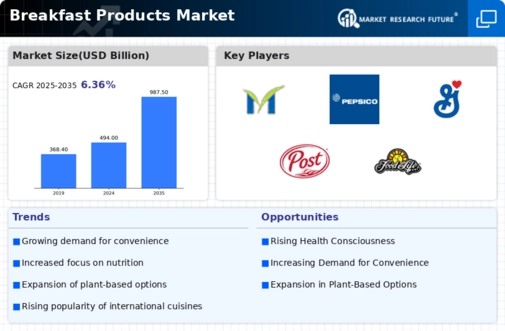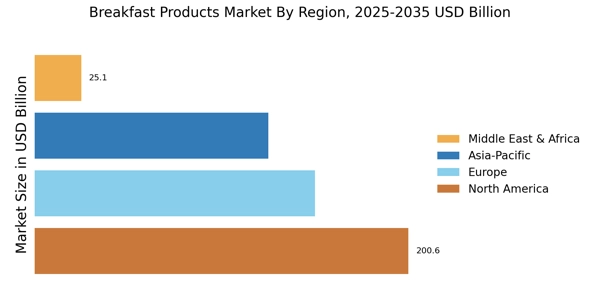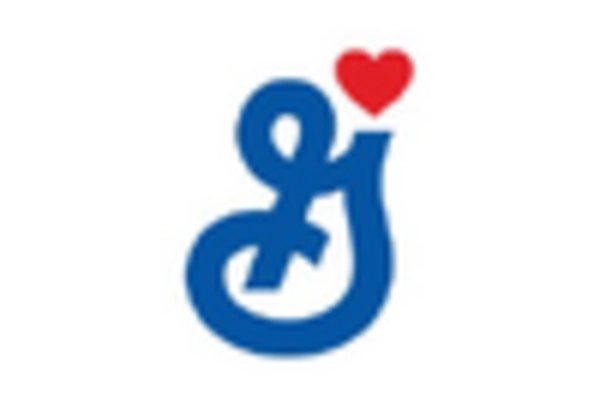Health Consciousness
The increasing awareness of health and wellness among consumers appears to be a pivotal driver in the Breakfast Products Market. As individuals prioritize nutritious options, the demand for products that are low in sugar, high in fiber, and rich in protein has surged. Recent data indicates that the market for healthy breakfast options is projected to grow at a compound annual growth rate of approximately 5.5% over the next five years. This trend is likely to encourage manufacturers to innovate and reformulate existing products to meet consumer expectations. Additionally, the rise of dietary preferences, such as gluten-free and organic, further influences purchasing decisions, compelling brands to diversify their offerings. Consequently, the Breakfast Products Market is witnessing a shift towards healthier alternatives, which may redefine traditional breakfast consumption patterns.
Diverse Consumer Preferences
The Breakfast Products Market is significantly influenced by the diverse preferences of consumers across different demographics. As cultural influences and dietary habits vary, there is a growing demand for a wide array of breakfast options that cater to various tastes and lifestyles. For instance, the popularity of international breakfast cuisines, such as Asian and Mediterranean, is on the rise, prompting brands to expand their product lines. Additionally, the increasing interest in plant-based diets has led to a surge in demand for vegan and vegetarian breakfast products. Market analysis suggests that this segment could grow by approximately 8% in the coming years. As manufacturers strive to meet these diverse consumer needs, the Breakfast Products Market is likely to witness a proliferation of innovative and culturally relevant products.
Convenience and On-the-Go Solutions
The fast-paced lifestyle of modern consumers seems to be a significant catalyst for the growth of the Breakfast Products Market. With an increasing number of individuals seeking quick and convenient meal solutions, ready-to-eat and portable breakfast items are gaining traction. Data suggests that the segment of breakfast bars and single-serve options is expanding rapidly, with a projected growth rate of around 6% annually. This shift towards convenience is likely driven by the need for time-efficient meal options that do not compromise on nutrition. As a result, manufacturers are focusing on developing products that cater to busy lifestyles, such as breakfast smoothies and instant oatmeal packets. The Breakfast Products Market is thus evolving to accommodate the demands of consumers who prioritize convenience without sacrificing quality.
Sustainability and Ethical Sourcing
The rising consumer preference for sustainability and ethical sourcing appears to be a transformative driver in the Breakfast Products Market. As awareness of environmental issues grows, consumers are increasingly inclined to choose products that are sustainably sourced and produced. This trend is reflected in the increasing demand for organic and fair-trade breakfast items, which are perceived as more responsible choices. Market data indicates that the organic breakfast segment is expected to witness a growth rate of approximately 7% over the next few years. Brands that prioritize sustainability in their supply chains and packaging are likely to resonate with environmentally conscious consumers, thereby enhancing their market position. Consequently, the Breakfast Products Market is adapting to these preferences, leading to a broader range of sustainable product offerings.
Technological Advancements in Food Production
Technological innovations in food production and processing are likely to play a crucial role in shaping the Breakfast Products Market. Advances in food technology, such as improved preservation methods and enhanced nutritional profiling, enable manufacturers to create products that are not only appealing but also healthier. For instance, the use of natural preservatives and fortification techniques has become more prevalent, allowing brands to offer products that meet the growing consumer demand for clean labels. Furthermore, the integration of automation and artificial intelligence in production processes may enhance efficiency and reduce costs, potentially leading to lower prices for consumers. As these technologies continue to evolve, they could significantly impact the Breakfast Products Market, fostering a competitive landscape that encourages innovation and quality improvement.


















Leave a Comment